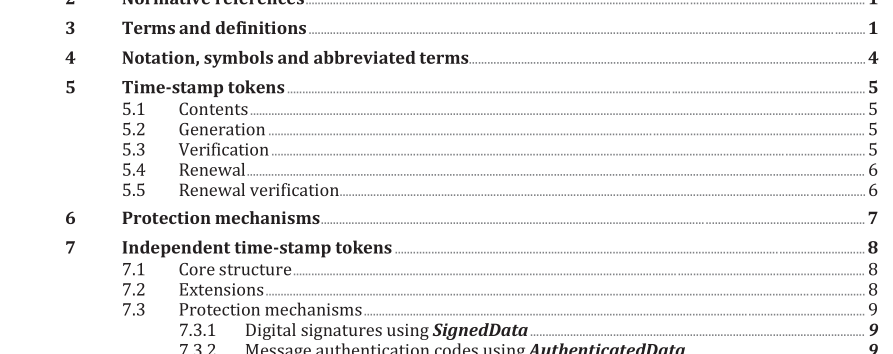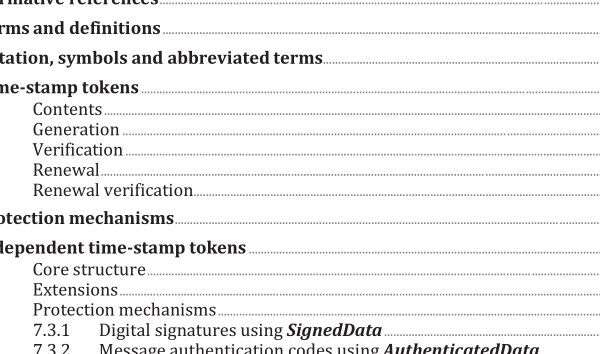ISO IEC 18014-2:2021 pdf download – Information security — Time- stamping services — Part 2: Mechanisms producing independent tokens.
3.4 time-stamp requester entity which possesses data it wants to be time-stamped [SOURCE: ISO/IEC 18014-1:2008, 3.14, modified – Note to entry has been removed.] 3.5 time-stamp verifier entity which possesses data and wants to verify that it has a valid time-stamp bound to it Note 1 to entry: The verification process can be performed by the verifier itself or by a trusted third party. [SOURCE: ISO/IEC 18014-1:2008, 3.16] 3.6 time-stamping authority TSA trusted third party trusted to provide a time-stamping service (3.2) [SOURCE: ISO/IEC 18014-1:2008, 3.17] 3.7 time-stamping unit TSU set of hardware and software which is managed as a unit and generates time-stamp tokens (3.1) 3.8 data origin authentication corroboration that the source of data received is as claimed Note 1 to entry: Data origin is sometimes called data source. [SOURCE: ISO 7498-2:1989, 3.3.22, modified — In the definition, the initial article “the” has been removed. Note 1 to entry has been added.] 3.9 data integrity property that data has not been altered or destroyed in an unauthorized manner [SOURCE: ISO/IEC 9797-1:2011, 3.4] 3.10 asymmetric key pair pair of related keys where the private key (3.11) defines the private transformation and the public key (3.12) defines the public transformation [SOURCE: ISO/IEC 9798-1:2010, 3.3] 3.11 private key key of an entity’s asymmetric key pair (3.10) that is kept private Note 1 to entry: The security of an asymmetric signature system (3.15) depends on the privacy of this key. [SOURCE: ISO/IEC 11770-1:2010, 2.35, modified — The definition was restricted to asymmetric signature system.] 3.12 public key key of an entity’s asymmetric key pair (3.10) which can usually be made public without compromising security [SOURCE: ISO/IEC 11770-1:2010, 2.36]
3.13 public key certificate public key (3.12) information of an entity signed by the certification authority [SOURCE: ISO/IEC 11770-1:2010, 2.37] 3.14 public-key infrastructure PKI infrastructure able to support the management of public keys able to support authentication, encryption, integrity or non-repudiation services [SOURCE: ISO/IEC 9594-8:2020, 3.5.60, modified — In the definition, the initial article “the” has been removed.] 3.15 asymmetric signature system system based on asymmetric cryptographic techniques whose private transformation is used for signing and whose public transformation is used for verification [SOURCE: ISO/IEC 9798-1:2010, 3.4] 3.16 digital signature data appended to, or a cryptographic transformation of, a data unit that allows a recipient of the data unit to prove the source (3.8) and integrity (3.9) of the data unit and protect against forgery, e.g. by the recipient [SOURCE: ISO/IEC 9798-1:2010, 3.11] 3.17 collision-resistant hash-function hash-function satisfying the following property: it is computationally infeasible to find any two distinct inputs which map to the same output [SOURCE: ISO/IEC 10118-1:2016, 3.1, modified — Note 1 to entry has been removed.]
ISO IEC 18014-2:2021 pdf download – Information security — Time- stamping services — Part 2: Mechanisms producing independent tokens






